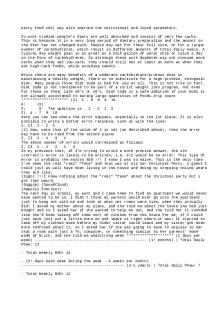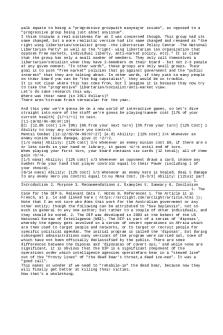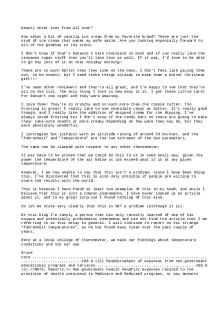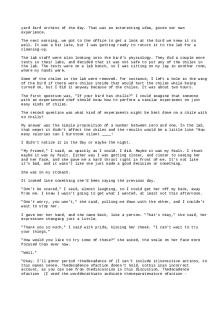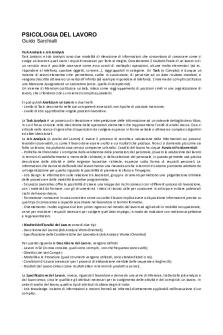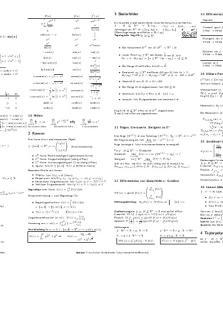Personhood analysis PDF

| Title | Personhood analysis |
|---|---|
| Author | Harrison Armstrong |
| Course | Bioethics |
| Institution | University of Sydney |
| Pages | 2 |
| File Size | 77.7 KB |
| File Type | |
| Total Downloads | 97 |
| Total Views | 160 |
Summary
Personhood, Michael Tooley– AnalysisMichael Tooley’s thought-provoking chapter, Personhood, explores how the term ‘person’ can be viewed in a variety of ways and how crucial understanding personhood is for the formation of many basic moral principles. To begin, Tooley touches on how in everyday disc...
Description
Personhood, Michael Tooley– Analysis Michael Tooley’s thought-provoking chapter, Personhood, explores how the term ‘person’ can be viewed in a variety of ways and how crucial understanding personhood is for the formation of many basic moral principles. To begin, Tooley touches on how in everyday discourse, the term ‘person’ can be viewed in two rather different ways. In some instances, it can be viewed as merely biological, where someone is regarded as a person due to their alignment with our species – homo sapiens (Tooley, 2009). On the other hand, entities that are not human; gods, angels, extra-terrestrials, may also be viewed as ‘persons’. Tooley progressively alludes to what makes someone a person. Is it a living human body, a body with high mental capacity or simply belonging to a species? Whichever definition of personhood is applied, filters down to how basic moral principles are formed. Tooley describes the ability of being a person as an individual who enjoys something comparable, in all relevant aspects, to the type of mental life that characterises normal adult human beings (Tooley, 2009). The argument between killing and letting die presents itself as a major theme throughout the chapter. If someone is classified as a person then the destruction of that person is intrinsically wrong. Based on this assumption, Tooley considers is it now intrinsically wrong to let someone die? He poses a hypothetical scenario, where an individual has their upper brain destroyed, causing the cerebral hemisphere (responsible for muscle functions and basic learnt actions) to be essentially killed. Not only does it consist of the cerebral hemisphere it also contains the neurophysiological basis for higher mental functions such as deliberation, self-consciousness, thought and memory (Roland, 1993). Tooley states there is discussion to be had surrounding whether the intended killing of this individual is inherently immoral? Or is it morally justified due to the individual’s cerebral nature? If the individual has no functioning mental life they are, according to Tooley, no longer a person. By this knowledge, the premeditated killing is morally justified. Potential personhood is the capacity to become a person, regardless of whether the capacity is likely to be realised (Warren, 1977). Tooley includes the idea of potential personhood when discussing the moral status of human embryos. Tooley maintains the idea that something cannot be a person if it does not possess the ability for rudimentary consciousness. Based on this idea, Tooley states that human embryos are not persons. However, when discussing the potential personhood of a human embryos, much more deliberation is needed as to whether abortion is morally acceptable. Embryos have an active potentiality for personhood, even if they do not realise. It is on this claim, that Tooley expresses how some may assert it is morally on par with destroying a person. Much like the killing of human embryos, Tooley discusses whether species membership is morally significant. This discussion becomes especially important when considering other entities that have the same moral status as persons. If something, while neither a person nor potential person, belongs to adult beings who contain personhood, then such an entity has the same moral status (Tooley, 2009). However, Tooley argues against this statement – basing an entities moral status upon its intrinsic properties, compared to its relations to other individuals should not be a matter of how someone regards it.
This chapter outlines how the concept of a person is critical when concerning the moral status of many entities. Additionally, it shows how the discussion of killing and letting die is especially important when referencing personhood. Tooley’s chapter helps readers gain further understanding into the idea of personhood and how far the term transcends across modern ethics. Bibliography - Roland, P., 2008. Brain activation. 2nd ed. Hoboken, N.J.: Wiley-Liss, p.215. - Warren, M., 1977. Do Potential People Have Moral Rights?. Canadian Journal of Philosophy, 7(2), pp.275-289....
Similar Free PDFs
Popular Institutions
- Tinajero National High School - Annex
- Politeknik Caltex Riau
- Yokohama City University
- SGT University
- University of Al-Qadisiyah
- Divine Word College of Vigan
- Techniek College Rotterdam
- Universidade de Santiago
- Universiti Teknologi MARA Cawangan Johor Kampus Pasir Gudang
- Poltekkes Kemenkes Yogyakarta
- Baguio City National High School
- Colegio san marcos
- preparatoria uno
- Centro de Bachillerato Tecnológico Industrial y de Servicios No. 107
- Dalian Maritime University
- Quang Trung Secondary School
- Colegio Tecnológico en Informática
- Corporación Regional de Educación Superior
- Grupo CEDVA
- Dar Al Uloom University
- Centro de Estudios Preuniversitarios de la Universidad Nacional de Ingeniería
- 上智大学
- Aakash International School, Nuna Majara
- San Felipe Neri Catholic School
- Kang Chiao International School - New Taipei City
- Misamis Occidental National High School
- Institución Educativa Escuela Normal Juan Ladrilleros
- Kolehiyo ng Pantukan
- Batanes State College
- Instituto Continental
- Sekolah Menengah Kejuruan Kesehatan Kaltara (Tarakan)
- Colegio de La Inmaculada Concepcion - Cebu



